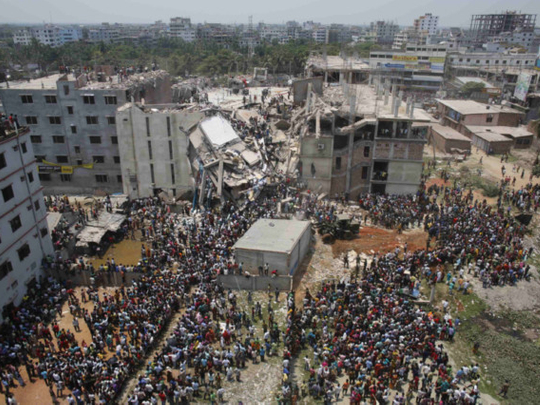
An hour before reading with horror last Thursday morning that workers at a clothes factory that collapsed in Bangladesh the day before had been ordered to return to work after their bosses decided cracks in the wall were nothing to worry about, I was deciding what to wear. The season has changed and most of my lighter clothes feel stale, while my children have grown and been promised new things that fit them. We must all go shopping, I thought. But where?
Not every time I open my purse, but regularly, I consume ethically, or as ethically as I can. I buy gas and electricity from the cooperative and shop mostly at the cooperative and local grocers. I do not buy factory-farmed meat or battery eggs and choose Fairtrade products when I can.
I do not think my spending habits are going to change the world and I do not think ethical consumption is a very effective lever in building a more just and sustainable society. That is what politics is for. However, I do think, if you can afford it, that it is worth trying to give your money to producers you approve of rather than those you know are avoiding taxes, paying workers a pittance or harming the environment.
Yet, when it comes to fashion, applying even the most modest ethical criteria is ridiculously hard. All the big chains including Primark, which had a supplier in the destroyed Rana Plaza building on Dhaka’s outskirts, and has promised “to provide support where possible” to the families of more than 270 workers known to have died have ethics policies that can be viewed online. None has a clearly labelled and readily availably Fairtrade or equivalent line on the shop floor.
When buying bananas, chicken or cashew nuts, labelling means consumers are faced with a simple choice: pay a bit more, and feel a bit better (about health, labour standards or animal welfare), if you want to and you can. This system isn’t perfect but over the past decade or so, alongside the growth of farmers’ markets and renewed enthusiasm for grow-your-own, has got better. We can usually see from the packet where supermarket produce was grown. Unlike organic foods, in recent years Fairtrade sales have grown.
By contrast the label on the trousers I am wearing, from Swansea-based label Toast, does not say where they were made. This is Toast’s policy and pretty weird if you ask me (though the company says it has high standards and “does not operate in a market where cost-cutting is more important than working conditions”). However, the thing about clothes, as with the processed mince that turned out to be horsemeat, is that supply chains are long. Even when you know your shirt was made in China or your socks in Turkey, you do not know the farmers, ginners, spinners, knitters or weavers who grew the crop and turned it into the cloth that made the clothes.
Ethical clothing campaigners, who claimed a victory last week when the sportswear giant Adidas agreed to pay Indonesian workers who lost their jobs when the PT Kizone factory closed two years ago, say retailers are slowly waking up to their responsibilities. HM last year announced plans to move to “100 per cent sustainably sourced cotton” by 2020, while Marks & Spencer claims to have a firm grip on the progress of its raw materials around the globe via a “director of sourcing”.
However, the disjunction between such boasts and the dreadful details of last week’s disaster in Bangladesh, with workers reporting that supervisors threatened to dock their pay if they did not return to work, cannot be ignored. Survivors of another Bangladesh factory disaster six months ago said doors were locked before more than 100 workers died in a fire. How is it that suppliers contracted to fill the shelves on our high streets can behave so recklessly?
The Rana Plaza collapse is all the more distressing because it seems to have been avoidable. Consumers cannot prevent such tragedies. Governments and NGOs must apply pressure, both to the retailers responsible for the people who make their clothes and to those in charge of regulating them. But until we can be more confident that workers’ lives are not being endangered, we must start to be more curious about where our clothes come from. Some of us are wearing clothes sewn by those killed last week in Dhaka.
— Guardian News & Media Ltd








